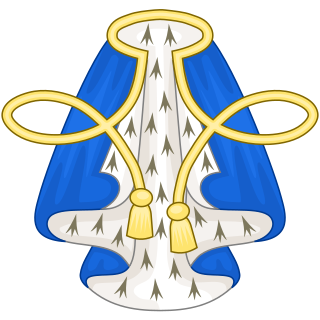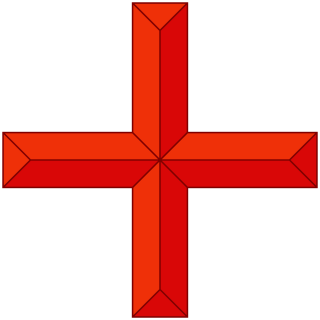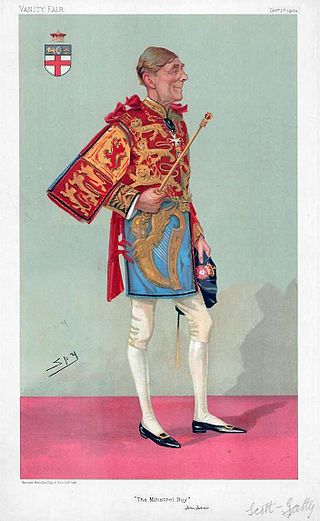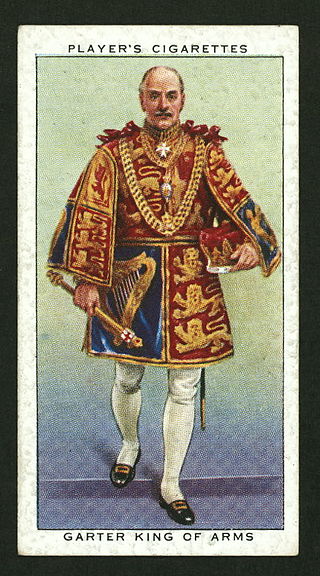
Sir Albert William Woods was an English officer of arms, who served as Garter Principal King of Arms from 1869 to 1904. The Woods family has a strong tradition of service at the College of Arms. Albert Woods was the son of Sir William Woods, Garter King of Arms from 1838 until his death in 1842. Likewise, the grandson of Albert Woods was Sir Gerald Woods Wollaston, who also rose to the rank of Garter King of Arms and served there from 1930 until 1944.

Norroy and Ulster King of Arms is the provincial King of Arms at the College of Arms with jurisdiction over England north of the Trent and Northern Ireland. The two offices of Norroy and Ulster were formerly separate. Norroy King of Arms is the older office, there being a reference as early as 1276 to a "King of Heralds beyond the Trent in the North". The name Norroy is derived from the Old French nort roy meaning 'north king'. The office of Ulster Principal King of Arms for All-Ireland was established in 1552 by King Edward VI to replace the older post of Ireland King of Arms, which had lapsed in 1487.

Windsor Herald of Arms in Ordinary is an officer of arms at the College of Arms in London.

Bluemantle Pursuivant of Arms in Ordinary is a junior officer of arms of the College of Arms in London. The office is reputed to have been created by King Henry V to serve the Order of the Garter, but there is no documentary evidence of this. There is, however, mention of an officer styled Blewmantle going to France in 1448. The first Bluemantle to be mentioned by name is found in a record from around 1484. The badge of office, probably derived from the original blue material of the Order of the Garter, is blazoned as A Blue Mantle lined Ermine cords and tassels Or.

Fitzalan Pursuivant of Arms Extraordinary is a current officer of arms in England. As a pursuivant extraordinary, Fitzalan is a royal officer of arms, but is not a member of the corporation of the College of Arms in London. As with many other extraordinary offices of arms, Fitzalan Pursuivant obtains its title from one of the baronies held by the Duke of Norfolk, Earl Marshal of England; the appointment was first made for the coronation of Queen Victoria in 1837. The badge of office was assigned in 1958 and is derived from a Fitzalan badge of the fifteenth century. It can be blazoned An Oak Sprig Vert Acorns Or, but is also recorded as A Sprig of Oak proper.

Portcullis Pursuivant of Arms in Ordinary is a junior officer of arms at the College of Arms in London. The office is named after the Portcullis chained Or badge of the Beauforts, which was a favourite device of King Henry VII. King Henry's mother was Lady Margaret Beaufort. The office was instituted around 1485, probably at the time of Henry's coronation. The badge of office is very similar to that of Somerset Herald of Arms in Ordinary, the latter being ensigned with the Royal Crown. The earliest recorded Portcullis Pursuivant was James or Jacques Videt, who was the plaintiff in a Common Pleas case in 1498 and again in 1500.

Rouge Croix Pursuivant of Arms in Ordinary is a junior officer of arms of the College of Arms. He is said to be the oldest of the four pursuivants in ordinary. The office is named after St George's Cross which has been a symbol of England since the time of the Crusades.
Charles WilfridScott-Giles was an English writer on heraldry and an officer of arms, who served as Fitzalan Pursuivant Extraordinary.

Sir Alfred Scott Scott-Gatty was a long serving officer of arms at the College of Arms in London and a successful composer.
Sir Henry Farnham Burke, (1859–1930) was a long-serving Anglo-Irish officer of arms at the College of Arms in London.

Sir Gerald Woods Wollaston was a long-serving officer of arms at the College of Arms in London. Wollaston's family had a firm tradition at the College of Arms. Wollaston's great-grandfather was Sir William Woods, Garter Principal King of Arms from 1838 until his death in 1842. His grandfather was Sir Albert William Woods who held the same post from 1869 to 1904.
Blanche Lyon Pursuivant of Arms in Ordinary was an English office of arms created during the reign of King Edward IV.
Major Charles Murray Kennedy St Clair, 17th Lord Sinclair, CVO, DL was a Scottish peer who spent his entire life in the service of the Crown; as a soldier, an officer of arms, an equerry in the Queen Mother's Household, a Scottish representative peer and as a Lord Lieutenant.
John Writhe was a long-serving English officer of arms. He was probably the son of William Writhe, who represented the borough of Cricklade in the Parliament of 1450–51, and is most remembered for being the first Garter King of Arms to preside over the College of Arms. Writhe is also notable for the contention that it was he who developed the system of heraldic cadency employed by English officers of arms to the present day.
Sir Christopher Barker was an officer of arms at the College of Arms in the City of London who rose to the highest position of Garter Principal King of Arms.
Lawrence Dalton was an officer of arms at the College of Arms in London. Dalton was one of thirteen children of Roger Dalton of Bispham, Lancashire, and his fourth wife. Lawrence Dalton also had two half-brothers and one half-sister from his father's first marriage. Little is known about Dalton's early life, and he is not known to have attended a university.

John Ives FRS and FSA was an antiquarian and officer of arms at the College of Arms in London. He was born in Great Yarmouth, the son of another John Ives, a wealthy merchant. He was baptized at a Congregationalist church and it was from a Congregationalist minister that he received his earliest educational instruction. He was planning to attend Gonville and Caius College but went to work in his father's counting-house in 1767.

Howard Pursuivant of Arms Extraordinary was an officer of arms extraordinary in England; that is, a royal herald but not a member of the College of Arms in London.
Sir Henry St George (1581–1644) was an English Officer of arms. He was the third son of the herald Sir Richard St George and his wife Elizabeth St John.
Sir Ralph Bigland was an English herald. He was the son of Joseph Owen of Salford, Lancashire, and Elizabeth-Maria Owen.

















































